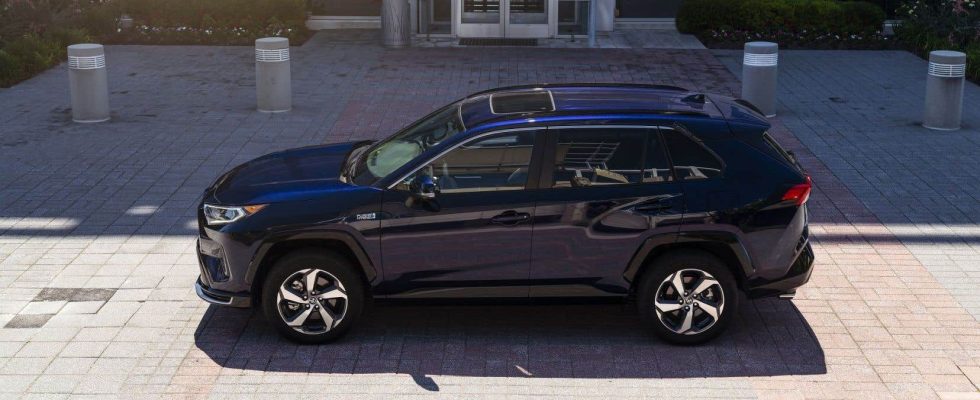Queuing is an art that few businesses outside of nightclubs have mastered. Talk to the automakers who are dribbling their electric vehicles, and who sometimes do business with dealers and customers who will do anything to cheat the system and make a quick buck.
The stories of doormen who handpick customers at the entrance to bars are transposed these days in the automotive sector. As the supply of electric vehicles begins to become more generous, people are trying to monetize on social networks their advantageous place in the queue to obtain the first copies arriving in the country.
An example appeared at the very end of March on the Facebook Marketplace in the form of a consumer warned by his dealer that he would be able to take the driving a brand new Toyota RAV4 Prime with plug-in hybrid engine. Rather than buying the vehicle himself, an individual put up for sale for $8,000 his privileged place on the waiting list for this vehicle, which is highly prized by Canadian motorists. “It’s my place on the waiting list that I sell,” said the seller in the announcement on Marketplace.
This sum was added to the retail price of just over $57,000 for a Toyota RAV4 Prime XSE thus submitted to a form of online auction that was questionable to say the least. Note that government purchase assistance subtracts $10,000 from the total amount paid by the buyer, taxes included.
A gray area of the law
Earlier this year, it was dealerships themselves trying to make a quick few thousand dollars more than expected by demanding up to $5,000 to sell directly to their own customers an electric vehicle whose originally intended buyer was withdrawn. Normally, the vehicle in question should have been returned to the manufacturer, who was responsible for contacting the next buyer on the official waiting list. As this buyer could be the client of another seller, it was more interesting for the merchant to perform this sleight of hand without the knowledge of the manufacturer than to follow the protocol to the letter.
A quick cash grab is sometimes more appealing to some merchants than strictly adhering to the internally established code of conduct. Obviously, greed is not the prerogative of professional sellers. The case of the RAV4 Prime cited above is not unique, notes Me Hubert Lamontagne, legal advisor for the Association for the protection of motorists (APA). The APA is a pan-Canadian organization that monitors seemingly suspicious transactions that regularly occur in the automotive sector.
Me Lamontagne saw an offer on Kijiji from an individual who had made an appointment to register a vehicle with the Société de l’assurance automobile du Québec (SAAQ). He sold his place on the waiting list for $40 to speak in person to a representative of the SAAQ. The timeframe for such a meeting could, until recently, stretch for weeks.
Reselling a place on a waiting list is a bit of a trick that the Consumer Protection Act does not regulate, says Ms.e The mountain. And like anything that goes beyond the legislative framework, there is a great risk of coming out disappointed, if not cheated. “The dealer could refuse to give the vehicle away,” he says. “By allowing such a gesture to pass, it does not respect the principle of the waiting list established by its manufacturer. Letting a shopper skip the line because they have deep pockets, let’s say that’s a case of poor customer service…”
The APA’s legal counsel cites another example where a merchant wanted to demand $5,000 more from a buyer who had advanced his position in line thanks to another person who had placed his name on the waiting list of several different vehicles. If he did not pay this amount, the dealer returned the vehicle to the manufacturer.
Contacted by The dutyToyota Canada and the Corporation of Quebec Automobile Dealers did not comment.
An incentive for the end of incentives
These situations were caused by a shortage of vehicles at dealerships during the pandemic. It mainly affected electric or plug-in hybrid vehicles, the marketing of which was announced, but not yet started. These situations are perhaps more than anecdotal, warns the APA.
If people can afford to shell out the equivalent of government assistance to buy an electric vehicle, just to get to said vehicle faster, maybe that assistance is superfluous, speculates Ms.e Hubert Lamontagne. “If people can afford to pay more than the suggested price, what is the point of purchasing assistance? he asks himself.
Instead, the APA goes back to a suggestion already made to the various levels of government: rather than offering purchase assistance that stimulates demand beyond supply, why not instead force the hand of manufacturers to increase the offer?
As components arrive in sufficient numbers at their factories to restart vehicle production, manufacturers are proceeding with temporary shutdowns to keep their inventory levels low. “That way, availability remains low, and prices can remain higher,” summarizes Me The mountain.
After all, in countries where high thresholds for electric vehicle sales have been put in place, manufacturers have complied with the rules. And waiting consumers don’t have to worry about being overtaken…
